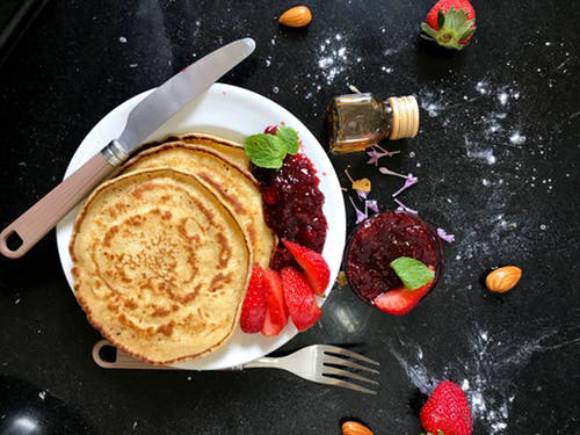
Breakfast Menu
What comes to your mind hearing the word breakfast? Some of us remember coffee, bread, and cheese. We believe that…
Jun 23, 2022
Let’s be honest here, who genuinely doesn’t like pasta? And why would they not like pasta? Saying yes to that would, if ever someone does, be something rather questionable. It’s almost as similar to saying that a kid doesn’t like chocolate. It would probably be understandable if a person doesn’t like a specific pasta dish, but pasta in general? No way! You may also see minimalist pizza menu designs.
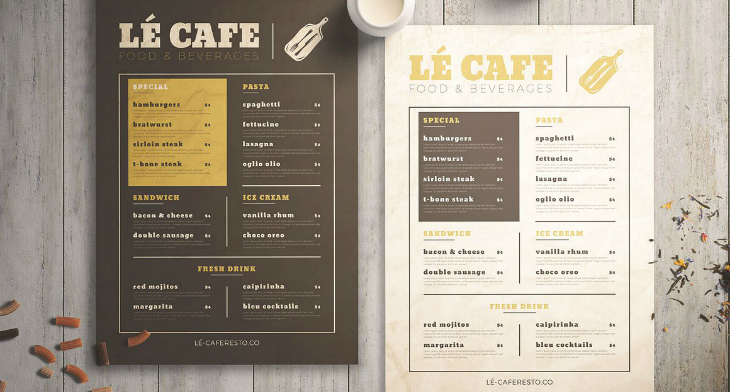
There are a lot of pasta varieties, and each variety can be prepared in various ways. Add those up and you’ll get countless of types of pasta dishes, and it would be almost impossible for a person not to like at least one of them. That said, if you’re someone who likes to eat pasta, then it’ll be very likely that you enjoy preparing them as well. You may also see restaurant menu templates.
In relation to that last part, if you like cooking pasta dishes and you want to share that passion with others, then it would be a great idea to put up a pasta or Italian-themed restaurant. And how would you be able to make your customers choose their dish? By giving them a menu, of course. Below is a collection of restaurant menu templates that you can download and use to make your own food menus, go ahead and check them out now. For similar templates, you may also want to check out our collection of Italian food menu templates.
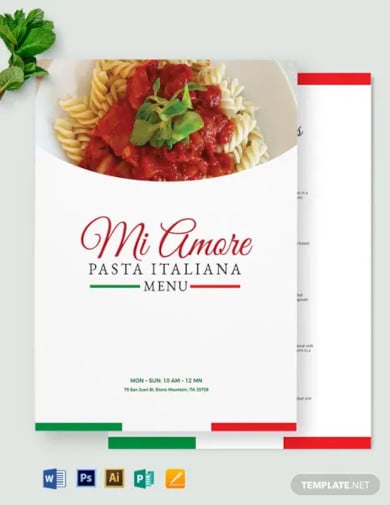

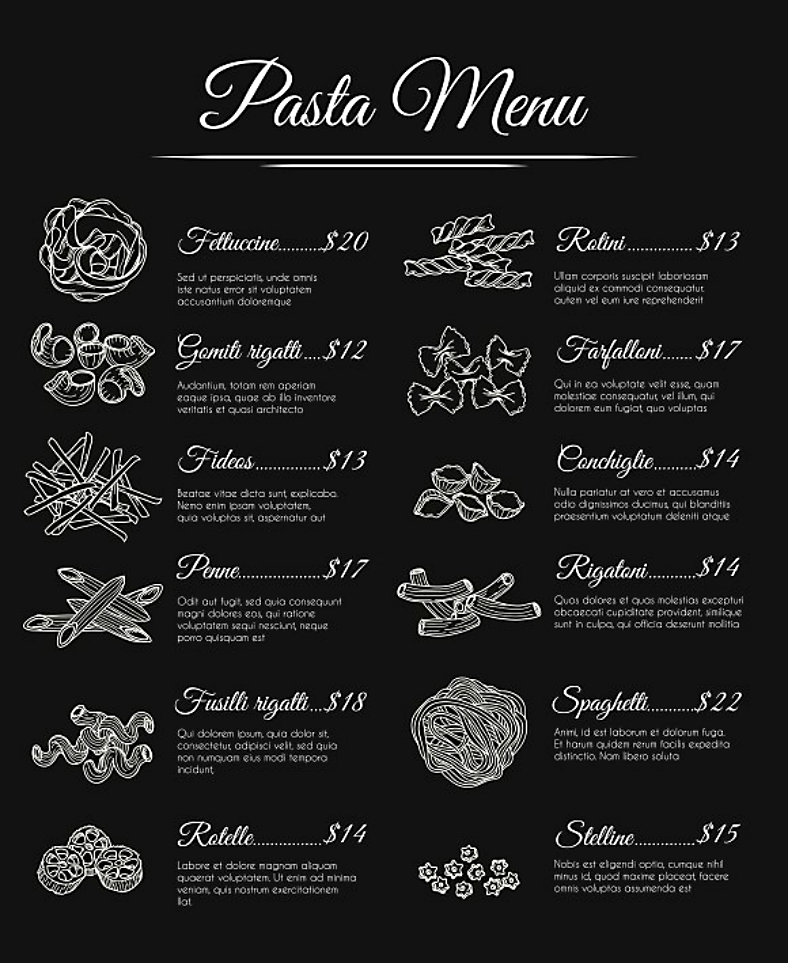
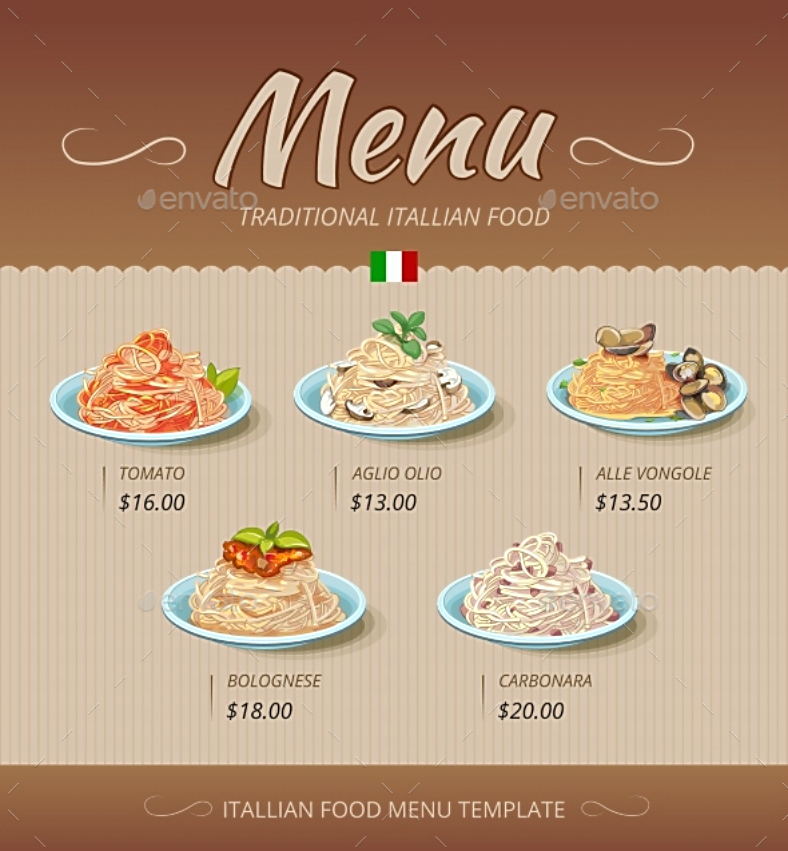
When we hear the word “pasta”, we easily associate it with Italian food, but is pasta really from Italy? We do know that people all over the world love it or its counterpart from that country which includes the wheat-based ramen noodles in Japan and China, and the rice-based pho noodles in Vietnam. But when it comes to how these exquisite dishes came about, that’s something that needs a little digging.
There was once a myth that was based on the writings of the explorer Marco Polo during the 13th century, and this myth mentioned that pasta was introduced to Italy by the Chinese people. But before this myth, several writings from the previous centuries were uncovered which also talked about dishes that were similar to pasta. You may also see scroll menu templates.
As early as the 1st century, Roman poet Horace’s writings have mentioned of a dish called lagana, which was made up of fine sheets of fried dough, and was considered as an accessible and easy to prepare food. Also, writings from the 5th century mentioned further about the lagana, and described it as a dish that consisted of layers of dough with meat stuffed in between the layers, a close resemblance to today’s lasagna. You may also see catering menu templates.
According to one food critic today, he believes that pasta actually originated from the Arabs, who introduced this food to Sicily during the 9th century. He further justifies his claims by saying that traces of pasta have been found in ancient Greece and that the Greeks were the first ones to invent a device that made dough strings, which is a reference to the pasta maker. You may also see takeaway menu designs.
During the 14th and 15th century, pasta became a sought-after dish mainly because of its easy storage qualities. Travelers and explorers who spent a lot of their time aboard ships found this quality convenient since they were allowed to store their share of the food without having to worry too much about it going to waste. This contributed a lot to its global popularity, and after a century, pasta was already recognized all over the world. You may also see price menu templates.
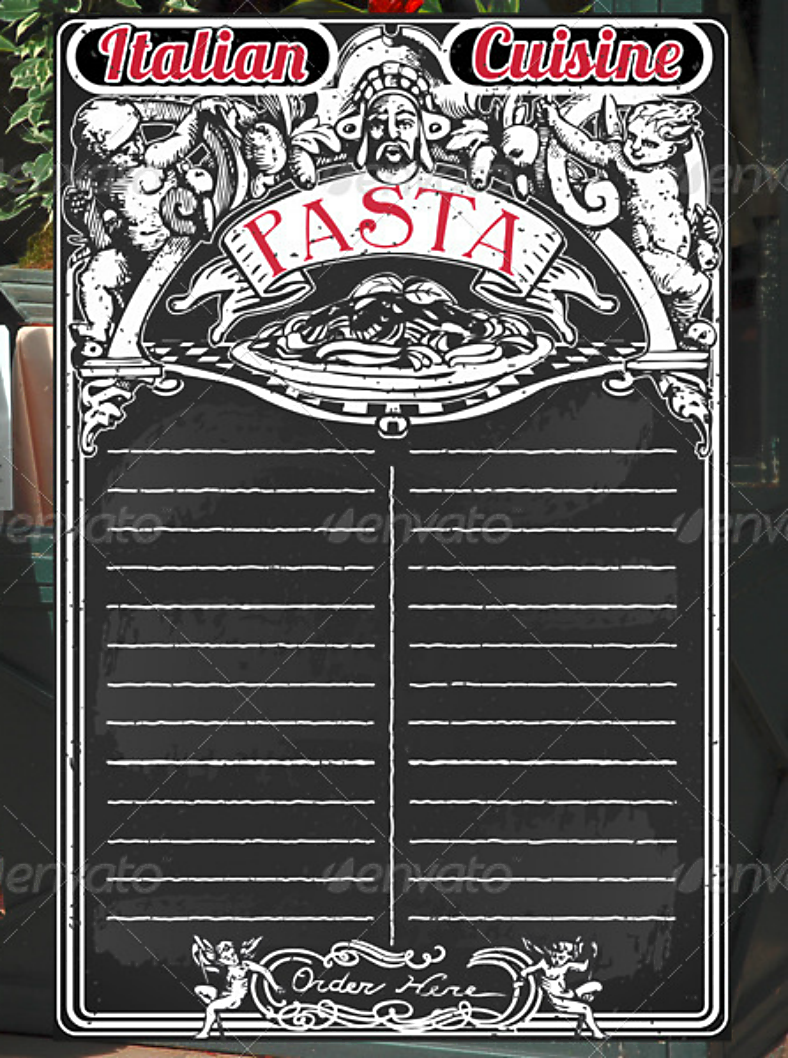
If you like the template above, we also have a few more blank menu templates that you may also be interested in.
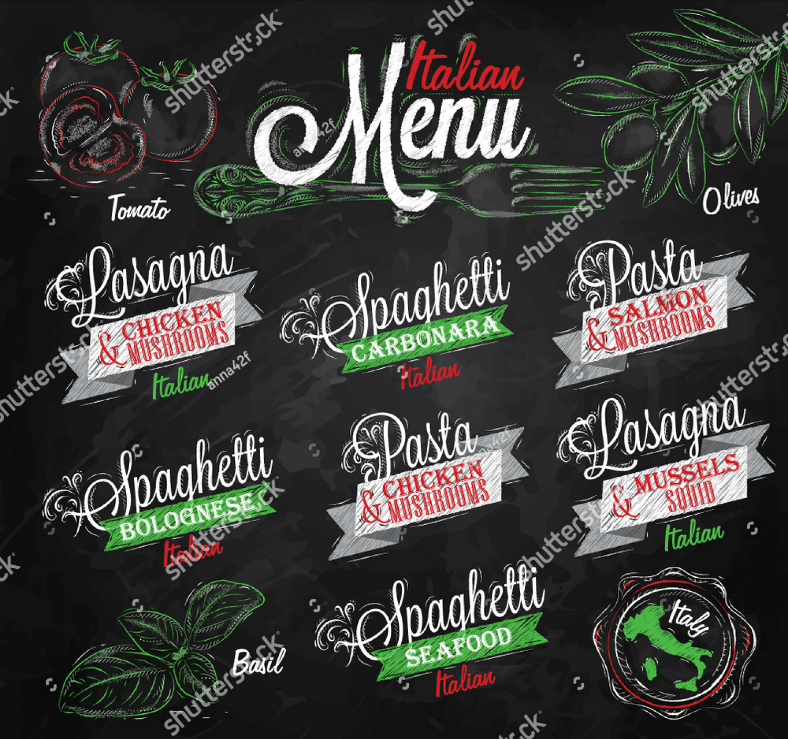
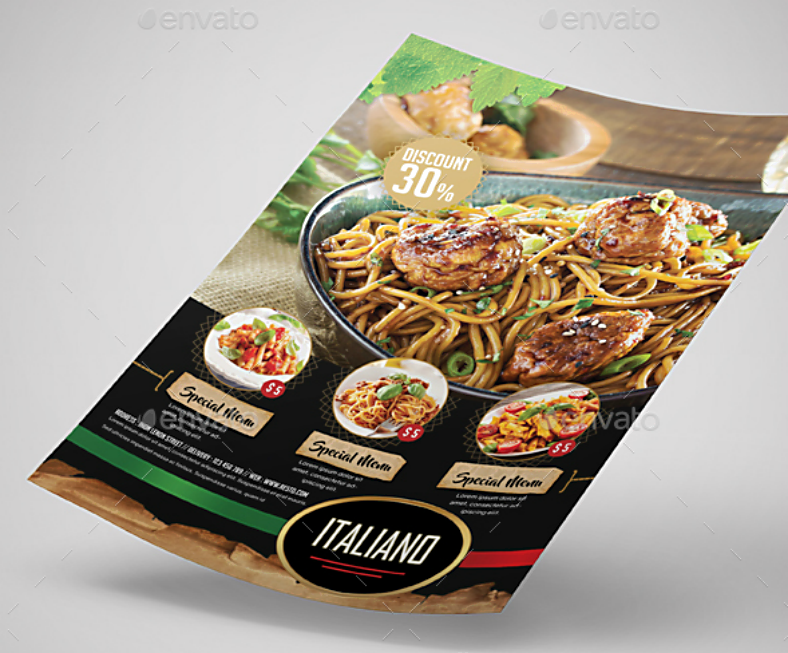
A type of pasta that consists of long and very thin strands. Among all other types of pasta, this one is the thinnest and is also the quickest to be cooked. Angel hair pasta goes along perfectly with thin, creamy sauces, chunky sauces are too heavy for it and may cause the strands to break easily. You may also see blank party menu templates.
A type of pasta that has its origins in Tuscany. This pasta is characterized as being wide, flat, and ribbon-like, and is actually made from eggs. Pappardelle is best served with thick meat sauces or stir-fried ingredients since it is capable of holding on to its consistency. You may also see cafe menu flyer designs.
Just like the pappardelle, this type of pasta are long and flat, though these are thin in width. The linguine is often described as a flattened version of the spaghetti, and is just as versatile. People often use this type of pasta with clam-based sauces or seafood dishes, but will do just as good when used with other kinds of sauces. You may also see birthday party menu templates.
Also a flat, ribbon-like type of pasta, with a width that’s not as thin as the linguine, but also not as thick as the pappaerdelle. Fettuccine pasta works well with thick sauces as well as chunks of meat and vegetables since it is a rather sturdy type of pasta. You may also see children’s party menu templates.
Characterized as small, curled, and hollow. The macaroni is best served with creamy sauces since it is capable of stuffing the sauce inside each curl, and this helps in bringing a lot of flavors with every bite. Macaroni is often used with either cream, tomato, or even cheese-based sauces. You may also see sample menu templates.
A tube-shaped and hollow type of pasta that is often seen as the straight counterpart of the macaroni. These are commonly about two inches in length and have diagonal cuts on both ends to easily allow sauces to go inside it. Just like the macaroni, penne pasta works well with cream, tomato, meat, and cheese sauces. However, it may be best to go for a slightly thicker consistency with your sauce to keep it from flowing out of the pasta tube. You may also see weekly menu templates.
Another type of pasta which is tube-like and hollow, similar to macaroni and penne, but unlike those two, this one has a smooth surface. Any type of sauce may work with this type of pasta, as long as it is thick enough that it can stick to its smooth surface. You may also see pub menu templates.
Basically, the lasagna is a type of pasta that consists of big and flat sheets that almost resemble thick paper or cardboard. The reason behind the lasagna’s popularity is most likely because of the dish that bears the same name. Similar to its ancestor, the lagana, the lasagna dish is comprised of layers of lasagna sheets, with a meaty tomato sauce stuffed in between layers, and topped with cheese and bacon. You may also see sample catering menu.

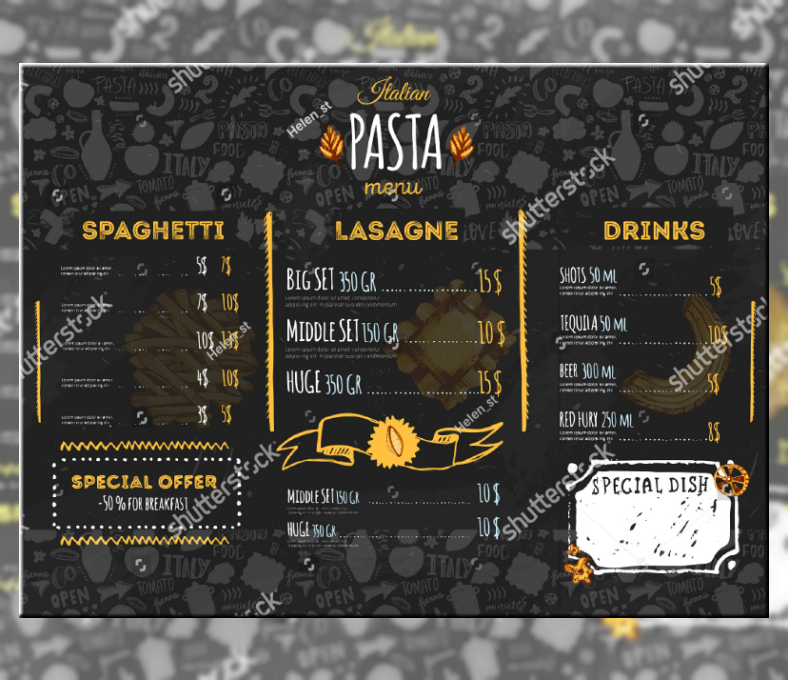
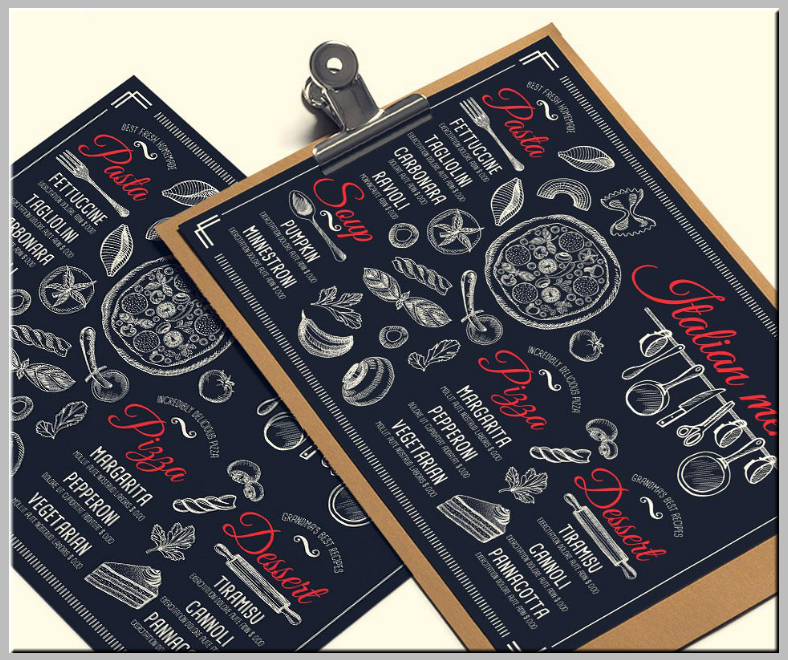
Considering that there are so many varieties of pasta, it would be quite understandable that these varieties have been made using different ingredients and have been prepared using different methods. But there are still ingredients that end up as the common denominators among the different types of pasta.
One of which is that pasta is commonly made up using a mixture of semolina flour and water. Semolina is actually a course type of flour which is derived from the endosperm of the durum wheat. Durum wheat is often referred to as the pasta wheat since it is the most common type used for making pasta. Another type of wheat used to make pasta is the farina, which has rougher granulations than the durum. Oftentimes, a combination of durum and farina wheat is used to make pasta.
Aside from just wheat and water, an egg is also sometimes thrown into the mixture for an added color and richness. For others, they would incorporate vegetable juices which include carrot and tomato to enhance the color and taste of the pasta. Over the recent years, people have been adding several herbs and spices such as garlic, thyme, and basil into their pasta mixture.
After the dough mixture has been made, it then goes to a series of machines or equipment which starts with the roller that flattens the dough and squeezes out any excess water. The next is the pasteurizer or steamer that helps in killing the bacteria that might have penetrated the dough. Once the pasta is clean enough for consumption, it is then cut depending on the type, dried, and then packed or cooked.
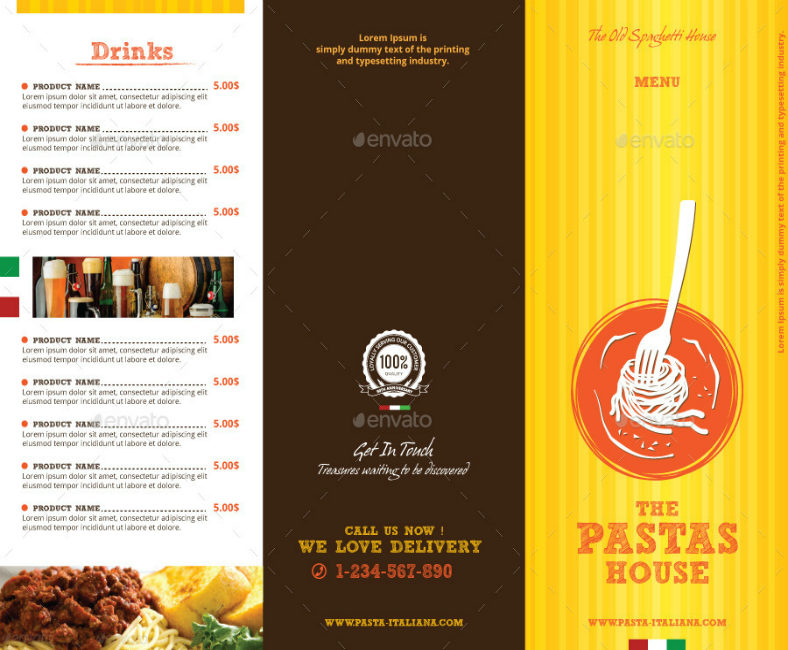
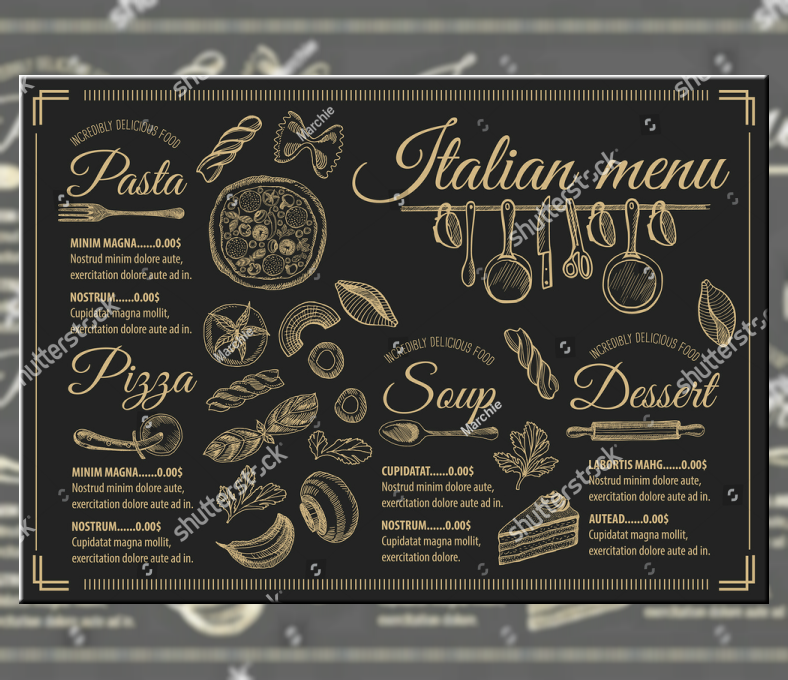
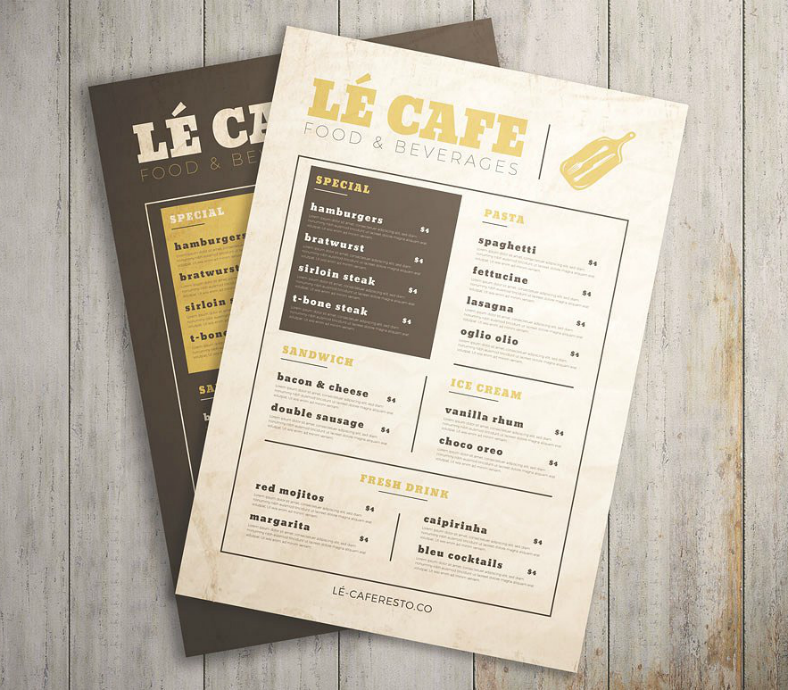
Looking for something that you can use everyday and at any time of the day? Yes, we may be referring to the template above, but we also have a collection of daily menu templates for you.
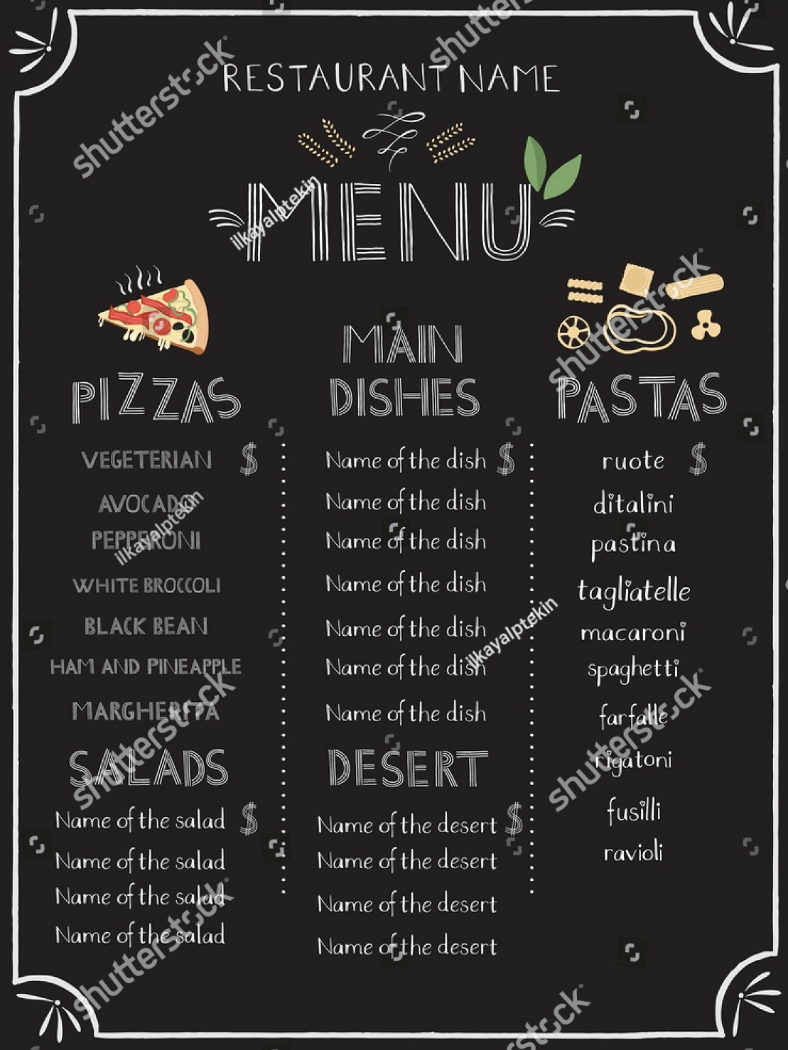
Aside from pasta and pizza, Italians are also fond of salad, and if you are too, then you may also want to check out our collection of salad menu templates.
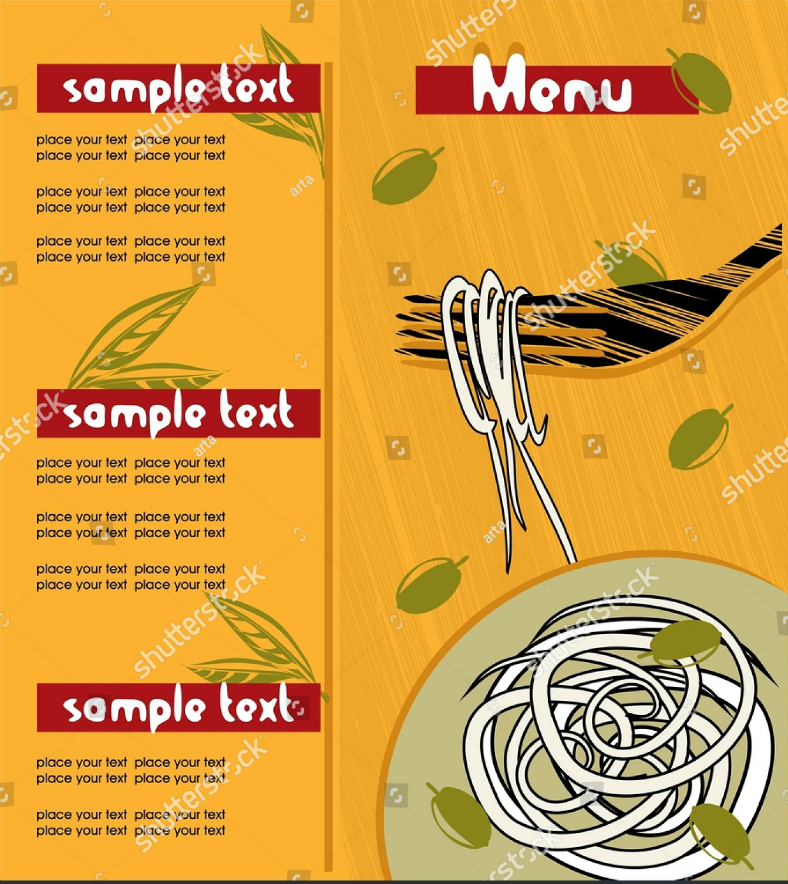
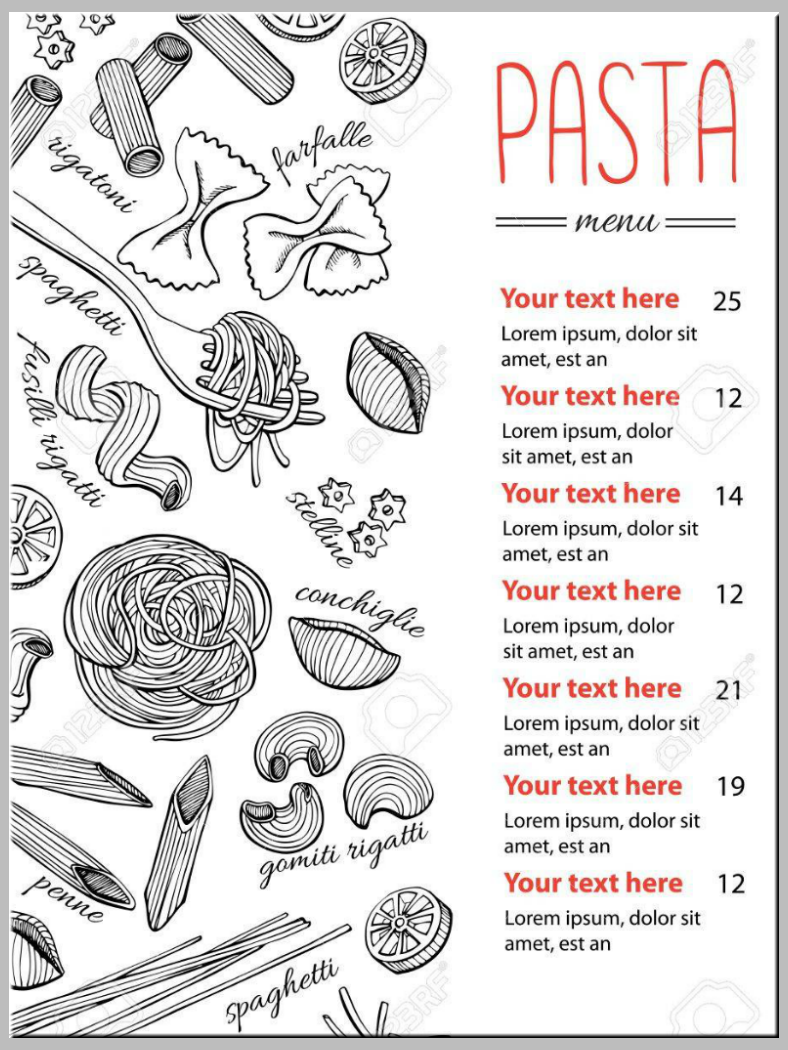
Did our food menu templates make you crave for pasta? Were they able to make your mouths salivate and your tummy rumble? Judging from the illustrations and the images used on the templates, we hope it did for you because it sure did for us. The artists who designed these templates definitely did a great job in making these templates tempting and mouthwatering, and these templates were designed by some of the leading graphic artists in today’s generation. Those statements alone are enough to make you want to download these exceptional pasta menu templates, yet it may also want you to check out our collection of pizza menu templates.
But if you still aren’t convinced by that information, then allow us to share more. These restaurant menu templates are fully editable and are actually comprised of multiple isolated elements that you can edit individually, meaning you may be able to edit specific parts of the template while neither altering the rest of the elements nor the overall design. And that’s not even the best thing about these templates’ edit ability, these templates are also capable of preserving their quality even after being edited, transformed, distorted, or resized.
From those qualities, you may now have the impression that these attractive menu templates come with a price. Well, they actually do, but a price that is quite reasonable. Considering the quality that you will be getting for the price, let’s just say that you won’t be able to find a deal that’s sweeter than this. These templates are very easy to access and download, you simply need to look for the design that works for you and just click on the download button. Doing so will redirect you to the source website which will guide you through the rest of the process. Now that we took care of those, go find that menu template that you want to use and click on that download button.

What comes to your mind hearing the word breakfast? Some of us remember coffee, bread, and cheese. We believe that…
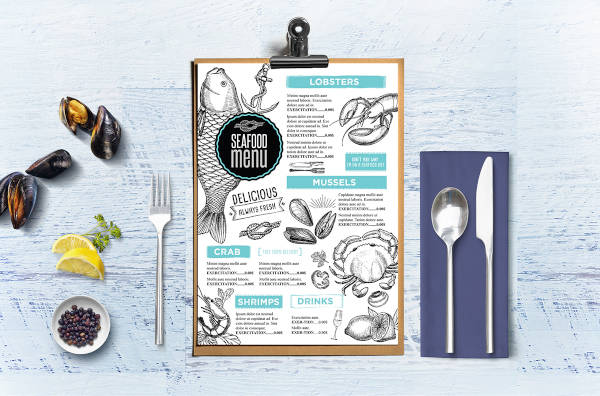
Students require more than just determination and the will to study in order to succeed in school. No matter how…
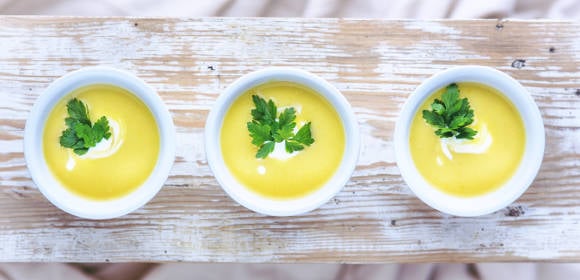
Running a restaurant can be a lot of work. Being that there is no shortage of hungry people, a restaurant…

Let’s be honest here, who genuinely doesn’t like pasta? And why would they not like pasta? Saying yes to that…

One of the highlights of any wedding ceremony is the bride and groom’s kiss. However, most guests just cannot get…
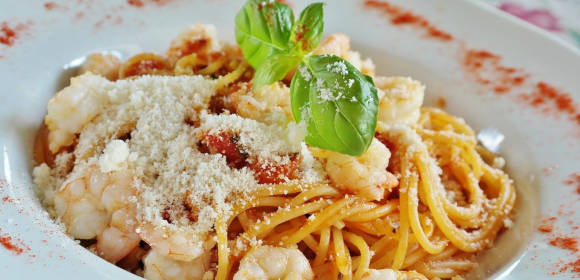
If there’s one ingredient that is prominently found in Italian dishes, it is tomatoes, and this could either be in…
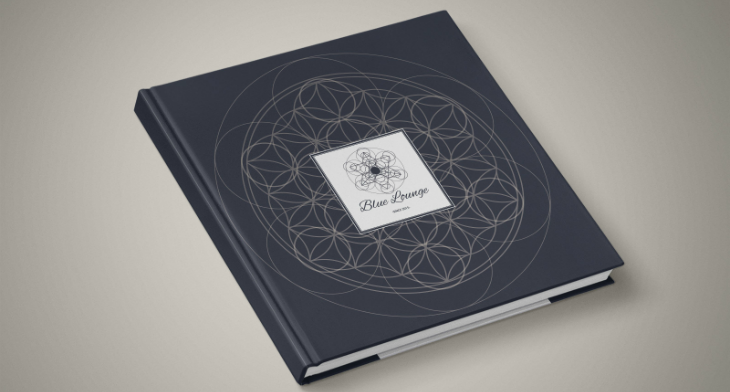
What could be the best place that people can just stay and relax without having to worry about anything? And…
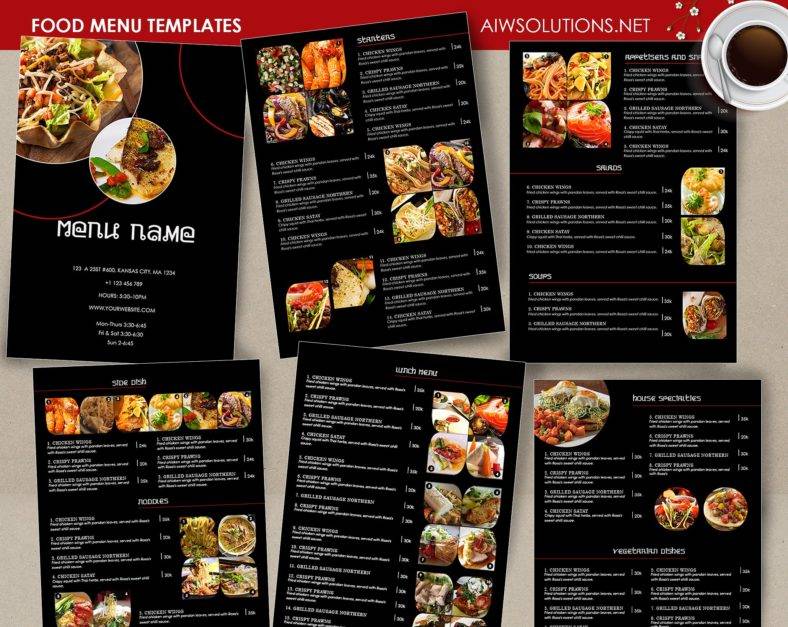
‘With every restaurant is a menu and with every menu is a successful restaurant’. This could not be truer as…

Fine dining restaurants serve very beautiful and meticulously done dishes. Customers are not only given a visual treat but are…